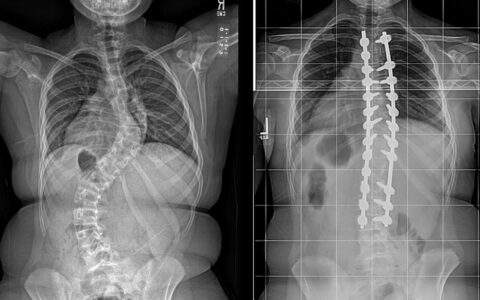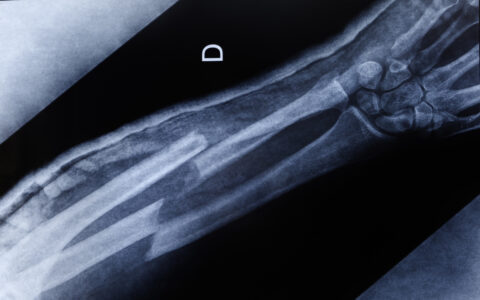When a child is suspected of having a musculoskeletal infection, care team members must quickly address four key issues that will direct treatment, including determining the degree of severity.
Focusing on these issues provides a logical framework for teams to identify, triage, and treat presenting patients. Vanderbilt University Medical Center researchers have recently published an updated, expanded version of this four-question framework in the journal Orthopedic Clinics of North America.
“The goal is to provide optimal treatment for musculoskeletal infections and, importantly, to keep a child from going into a state of multiorgan dysfunction,” said Stephanie Moore-Lotridge, Ph.D., assistant professor of orthopeadics at VUMC.
“Kids are very resilient. But if the infection is really robust with a powerful inflammatory response, this can lead to organ dysfunction across the body that can be fatal.”
“The goal is to keep any child from going into a state of multiorgan failure.”
The Questions
The first issue addressed in the framework is to determine whether the condition actually is an infection and, if so, pinpoint its location. Physicians are reminded here that the problem may stem from other sources, such as trauma or cancer.
Once these mimickers are ruled out, the second question asked what pathogen is causing the infection. This helps providers determine the best antibiotics and treatment strategies for that specific pathogen and infectious location, Moore-Lotridge said.
Thirdly, clinicians are directed to ask: How severe is it: is it localized or present in multiple spots?
Answering this can help in deciding what types of interventions, in addition to antibiotics, may be needed and what outcomes to expect, Moore-Lotridge said, adding that a widely dispersed infection can indicate greater severity.
“Severity is a very important indicator, as it is proportional to the body’s inflammatory response to the infection,” she said. “A severe response may be essential to help fight the infection, but it also systemically impacts adverse outcomes. The medical field is continually improving in our capacity to measure the body’s acute phase response to prognosticate the risk of adverse outcomes.”
Fourth to be considered is what the treatment should be.
“My clinical partners take all the pieces of information we’ve gained with the first three questions to decide how to treat it,” Moore-Lotridge said.
In cases of musculoskeletal infections, this can include antibiotics with or without surgical intervention. For severe musculoskeletal infections, timely treatment is essential to stop the infection and control the body’s response to it.
Severity Gets Its Due
Writing in their update, the Vanderbilt team noted that “pediatric MSKI accounts for nearly one in 10 pediatric orthopedic consults at academic tertiary care centers. Fewer conditions in pediatric orthopedics are as enigmatic or carry higher stakes for a child than potential musculoskeletal infections.”
Using the four-step framework cuts to the heart of these cases. The researcher stressed that infection severity matters because while the location or locations of the infection and the specific tissues involved can help guide treatment, a focus on severity is essential to prevent adverse outcomes.
Determining infection severity helps guide treatment and gauges a child’s potential needs for clinical supports for various organ systems and for oxygen, needs that may be best addressed in the ICU.
Musculoskeletal infections are generally treated collaboratively by hospitalists, infectious disease specialists, and orthopedists working together. Everyone needs to speak the same language and understand the importance of severity and how to manage it, the article emphasizes.
Improving Severity Measures
The Vanderbilt Orthopaedic Translational Education and Research Group, where Moore-Lottridge and her colleagues conduct research, also recently had an article published on the importance of C-reactive protein measures to assess the need for escalated care in children with musculoskeletal infections.
That study tested the hypothesis that recording C-reactive protein (CRP) measurements taken immediately before and two days after surgical debridement could predict the need for a change of course medically, such as switching antibiotics or escalating surgical procedures, such as additional debridement.
The hypothesis held up.
“For each 10-unit increase in preoperative CRP or postoperative change in CRP, there was a 21 percent or 22 percent increased risk of needing escalated care, respectively,” the authors found.
Accordingly, they anticipate the use of such periodic CRP measures becoming the standard of care in the acute setting, for the evaluation of severity and disease progression in children’s musculoskeletal infections.
However, not all institutions have the resources to do CRP testing quickly, so alternative measures for assessing the severity of musculoskeletal infections were proposed.
Work recently presented by the group at the 2024 Pediatric Society of North America Annual meeting demonstrated that data from a complete blood count with differential (CBC with diff) may also have great potential to serve as a reliable measure of an infection’s severity.
This team’s work was funded in part by the Caitlin Lovejoy Research Fund.





